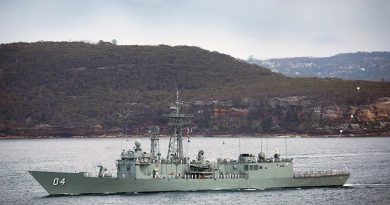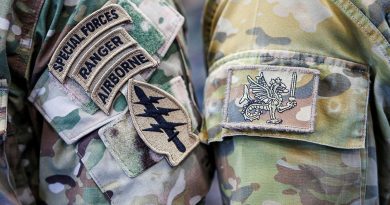Looking back at missile testing in Australia

Lessons learnt from British missile testing gave Australia decades of advantage. This history article tells the story of Defence Science and Technology Group’s* vital role in the research behind this, as part of a relationship that continues today.
CAPTION: A Bristol Bloodhound surface-to-air missile on display in Williamtown, NSW, during Air Force week in 1966. Story by Bill Condie. Photo courtesy AWM P00448.034.
The announcement of AUKUS, Australia’s enhanced trilateral security partnership with the UK and US, is the latest episode in the long-running story of two of the country’s oldest and closest alliances.
Over the decades Australia has contributed greatly to the security of all three, driven by the ingenuity of its scientists and the imperatives of its unique geography.
Mutually beneficial research relationships, first with the UK and later with the US, have played to each nation’s strengths and often delivered benefits for decades after projects have been initiated.
For example, while most people know something of the British nuclear testing in the deserts of South Australia, fewer know of the ongoing missile tests such as that of the Bristol Bloodhound, a ramjet powered surface-to-air missile developed during the 1950s.
Data accumulated during the Woomera test flights were sent in the first instance to the Long Range Weapons Establishment (LRWE), established under the terms of the ‘Anglo-Australian Joint Project’ and based at just to the north of Adelaide city, home to a major Defence Science & Technology Group (DSTG) site.
Playing to Australia’s strengths
Scot Allison, a retired DSTG physicist and former Director of the Electronics Research Laboratory at Salisbury, whose work spanned missile development, air, and ship defences, said Australia’s computer facilities were better than the UK at the time.
CAPTION: Scot Allison, retired DSTG physicist and former Director of the Electronics Research Laboratory at Salisbury.
“The British encouraged us to develop models so that we could run the telemetry test data to make sure their missiles were working properly,” he said.
“We were virtually a component of the British research establishment tasking us on behalf of the Ministry of Defence.”
The Australians, starting with Alex Biggs and Ted Hayman, then followed by Mr Allison and his colleague Bill Dixon, worked alongside a British contractor who reported the results of the modelling back to organisations such as the Royal Aircraft Establishment, The Royal Signals and Radar Establishment.
“It was a joint British-Australian effort,” Mr Allison said.
It was a time of great technological progress, not least the development of solid state circuitry then being pioneered by the British.
Of the two versions of the Bloodhound missile, Mark 1 used vacuum tubes while Mark II used frequency modulated, continuous wave, solid state receivers.
“Not only did we have all this data, but we were also learning about this very advanced tech,” Mr Allison said.
Australia’s own brand of can-do ingenuity
“Bill Dixon did a fantastic job because he used modern electronic circuitry in conjunction with the analogue computer that we could play the tapes into it,” Mr Allison said.
“At the time we had an IBM 7094 in Salisbury to help with the trials data. It was one of the most advanced computers you could buy, and it had 32K of memory.”
The British ran many top-secret tests, fitting special jamming equipment on the target aircraft.
Other tests were designed to pick out targets from the radar ground clutter, vitally important for low-level flight and something that was to pay dividends with Australian modelling during the Vietnam War.
The Woomera trials used Jindivik pilotless target aircraft fitted with signal enhancers.
“You got a beautiful, clear signal for the missile to home in on, and that was a good way of testing the missile internals,” Mr Allison said.
“But on other Jinidiviks, they put all sorts of sophisticated electronic warfare devices to confuse the seekers on the missile and the radar on the ground.
“Those things were very much held close to chest by the British but we had access to most of it.”
At the time, the attitude of the Australian Defence establishment was opposed to Australia developing its own missiles, figuring that any materiel they needed they would buy overseas.
But regional developments, such as the Malaysian Emergency, then the Borneo confrontation under Indonesian President Surkano in the early 1960s, suddenly presented strategic uncertainty.
Up for the challenge
In late October 1963, the Menzies Government announced it had sealed a deal with the US for the purchase of 24 F-111 aircraft.
The challenge of adapting them to Australia’s unique circumstances fell to Allison and his team, a task all that earlier work with the British had prepared them for.
“The F-111 was a marvellous aircraft,” Mr Allison said.
“It had a huge range, and you could carry a very big bomb load. It had terrain-following radar that would let it fly along at 150 feet in all-weather at night.”
But those systems had been designed with a view to flying through Fulda Gap – the corridor in eastern Germany through which NATO expected any Soviet attack to come – and not for operations in steamy Southeast Asian jungles.
“The knowledge of the Southeast Asian environment was minimal,” Mr Allison said.
“We had no real intelligence capability to sort out the Southeast Asian environment that would make military sense.”
As the joint project with the British missile testing started to wind down, Vietnam started to wind up and some in Navy and the RAAF began to make the case for developing Australian-specific solutions.
“Wing Commander Roy Collinson, from RAAF, and Arthur Callums from Navy decided we had to do better, and Collinson began looking at electronic warfare from an RAAF point of view,” Mr Allison said.
And so, by 1968 Defence Science was looking at how RAAF would be able to operate in a Southeast Asian environment against a country which had access to Soviet weaponry.
Drawing on experience from the British project and aided by an enormous volume of data released to Australia by the US, Allison’s team began analysing what Soviet missile capabilities would do to the RAAF if it flew against it.
“Because of our experience we were able fairly quickly to get simulations of these missiles up to work out how the systems would work against us and what kind of countermeasures we could have on our aircraft that could be effective against them,” Mr Allison said.
And in an example of how productive UK-US-Australian research relationships can be for all three parties, it was now time to pay back the British for all that early experience.
“I went to work at Royal Aircraft Establishment and by then Bill Dixon and I had managed to get across three or four Soviet missile systems that were significant in Europe at that time,” Mr Allison said.
“The British electronic warfare research organisations hadn’t ever used simulations of missiles to assess the effect of their countermeasures when they designed them. They just hadn’t done it. I took all this data with me to UK and I left all that with them.”
* More than 2000 Defence scientists, engineers, IT specialists and technicians form the Defence Science and Technology Group responsible for providing scientific advice and high-tech solutions for Australia’s Defence and national security agencies.
.
.

.
.






